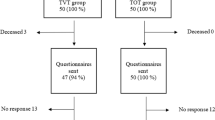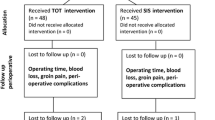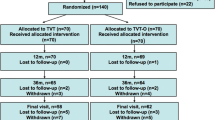Abstract
Introduction and hypothesis
The aim of this study was to prospectively and randomly compare the outcome of surgical treatment of female stress urinary incontinence (SUI) using the same outside–inside transobturator technique with biological (PelviLaceTO®) or synthetic (UretexTO®) material sling, evaluating if the biological material can prevent vaginal erosion retaining the “cure rate” of this surgical technique.
Methods
Seventy patients with SUI were selected, randomly assigned to either UretexTO® (n = 34) or PelviLaceTO® (n = 36), and underwent the same surgery.
Results
There is no significant difference between two study arms with regard to objective and subjective cure rates and quality of life. In both groups we had an overlap cure rate (UretexTO® group 88.2% vs PelviLaceTO® group 88.8%) at mean 3 years follow-up. It found no perioperative complications nor vaginal erosions.
Conclusions
UretexTO® and PelviLaceTO® are two similarly safe and efficient slings in the management of SUI, with a good patient satisfaction and without any complications.



Similar content being viewed by others
References
Petros P, Ulmsten U (1990) An integral theory of female urinary incontinence. Experimental and clinical considerations. Acta Obstet Gynecol Scan Suppl 153:7–31
Ulmsten U, Petros P (1995) Intravaginal slingplasty (IVS): an ambulatory procedure for treatment of female urinary incontinence. Scand J Urol Nephrol 29:75–82
Delorme E (2001) La bandelette trans-obturatrice: un procede mini-invasif pour tra iter l’incontinence urinaire d’effort de la femme. Prog Urol 11:1306–1313
Delorme E, Droupy S, de Tayrac R (2003) La bandelette trans-obturatrice (Uratape®). Un nouveau procédé mini-invasif de traitement de l’incontinence urinaire de la femme. Prog Urol 13:656–659
Domingo S, Alamá P, Ruiz N, Perales A, Pellicer A (2005) Diagnosis, management and prognosis of vaginal erosion after transobturator suburethral tape procedure using a nonwoven thermally bonded polypropylene mesh. J Urol 173:1627–1630
Amid PK (1997) Classification of biomaterials and their related complications in abdominal wall hernia surgery. Hernia 1:15–21
Galmès Belmonte I, Diaz Gomez E (2004) Son iguales todos los sistemas empleados para corregir la incontinencia urinaria mediante mallas libres de tensión? Actas Urol Esp 28:487–496
Natale F, La Penna C, Padoa A, Agostini M, De Simone E, Cervigni M (2009) A prospective, randomized, controlled study comparing Gynemesh, a synthetic mesh, and Pelvicol, a biologic graft, in the surgical treatment of recurrent cystocele. Int Urogynecol J Pelvic Floor Dysfunct 20:75–81
Rudnicki M (2007) Biomesh (Pelvicol) erosion following repair of anterior vaginal wall prolapse. Int Urogynecol J Pelvic Floor Dysfunct 18:693–695
Auward W, Freeman RM, Swift S (2004) Is the pelvic organ prolapse quantification system (POPQ) being used? A survey of members of the International Continence Society (ICS) and the American Urogynecologic Society (AUGS). Int Urogynecol J Pelvic Floor Dysfunct 15:324–327
Abrams P, Cardozo L, Fall M, Griffiths D, Rosier P, Ulmsten U et al (2002) The standardisation of terminology of lower urinary tract function: report from the Standardisation Sub-Committee of the International Continence Society. Neurourol Urodyn 21:167–178
Ingelman-Sundberg A, Ulmsten U (1983) Surgical treatment of female stress urinary incontinence. Contrib Gynecol Obstet 10:51–56
Crystle CD, Charme LS, Copeland WE (1971) Q-tip test in stress urinary incontinence. Obstet Gynecol 38:313–316
Kelleher CJ, Cardozo LD, Khullar V, Salvatore S (1997) A new questionnaire to assess the quality of life of urinary incontinent women. BJOG 104:1374–1379
Rogers RG, Coates KW, Kammerer-Doak D, Khalsa S, Qualls C (2003) A short form of the Pelvic Organ Prolapse/Urinary Incontinence Sexual Questionnaire (PISQ-12). Int Urogynecol J Pelvic Floor Dysfunct 14:164–168
Parker DM, Armstrong PJ, Frizzi JD, North JH Jr (2006) Porcine dermal collagen (Permacol) for abdominal wall reconstruction. Curr Surg 63:255–258
Novara G, Galfano A, Boscolo-Berto R, Secco S, Cavalleri S, Ficarra V et al (2008) Complication rates of tension-free midurethral slings in the treatment of female stress urinary incontinence: a systematic review and meta-analysis of randomized controlled trials comparing tension-free midurethral tapes to other surgical procedures and different devices. Eur Urol 53:288–308
Kobashi K (2009) Management of erosion of graft materials in pelvic floor reconstruction. Sci World J 9:32–36
Spinosa JP, Dubuis PY, Riederer B (2007) Transobturator surgery for female stress incontinence: a comparative anatomical study of outside-in vs inside-out techniques. BJU Int 100:1097–1102
De Lancey JO (1988) Struttural aspects of the extrinsic continence mechanism. Obstet Gynecol 72:296–301
Deprest J, Zheng F, Konstantinovic M, Spelzini F, Chaerhout F, Steensma A et al (2006) The biology behind fascia defects and the use of implants in pelvic organ prolapse repair. Int Urogynecol J Pelvic Floor Dysfunct 17:S16–S25
Rabah DM, Spiess PE, Begin LR (2002) Tissue reaction of the rabbit urinary bladder to tensionfree vaginal tape and porcine small intestinal submucosa. BJU 90:601–606
Schoenmaeckers EJ, van der Valk SB, van den Hout HW, Raymakers JF, Rakic S (2009) Computed tomographic measurements of mesh shrinkage after laparoscopic ventral incisional hernia repair with an expanded polytetrafluoroethylene mesh. Surg Endosc 23:1620–1623
LeBlanc KA (2001) Complications associated with the plug-and-patch method of inguinal herniorrhaphy. Hernia 5:135–138
García-Ureña MA, Vega Ruiz V, Díaz Godoy A, Báez Perea JM, Marín Gómez LM, Carnero Hernández FJ et al (2007) Differences in polypropylene shrinkage depending on mesh position in an experimental study. Am J Surg 193:538–542
Araco F, Gravante G, Sorge R, Overton J, De Vita D, Sesti F et al (2008) TVT-O vs TVT: a randomized trial in patients with different degrees of urinary stress incontinence. Int Urogynecol J Pelvic Floor Dysfunct 19:917–926
Minaglia S, Ozel B, Hurtado E, Klutke CG, Klutke JJ (2005) Effect of transobturator tape procedure on proximal urethral mobility. Urology 65:55–59
Gandhi S, Kubba LM, Abramov Y, Botros SM, Goldberg RP, Victor TA et al (2005) Histopathologic changes of porcine dermis xenografts for transvaginal suburethral slings. Am J Obstet Gynecol 192:1643–1648
Roth CC, Winter JC, Woodruff AJ (2007) What’s new in slings: an update on midurethral slings. Curr Opin Urol 17:242–247
de Tayrac R, Alves A, Thérin M (2007) Collagen-coated vs noncoated low-weight polypropylene meshes in a sheep model for vaginal surgery. A pilot study. Int Urogynecol J Pelvic Floor Dysfunct 18:513–520
Acknowledgements
We thank all patients who have placed their trust on us and allowed us to study, learn, and grow and Sandy Langford for her help with translation.
Integrity of research and reporting
The authors Raffaele Paparella, Monia Marturano, Laura Pelino, Alessandra Scarpa, Giovanni Scambia, Giuseppe La Torre, Pierluigi Paparella, qualify by having participated actively and sufficiently in the study reported. The authors give their final approval of the version of the manuscript being submitted. The authors confirm that all bylined authors fulfill all conditions.
Ethical standards
This human study has been approved by the appropriate ethics committee, and it has therefore been performed in accordance with the ethical standards laid down in the 1964 Declaration of Helsinki. All persons gave their informed consent prior to their inclusion in the study.
Conflicts of interest
None.
Author information
Authors and Affiliations
Corresponding author
Rights and permissions
About this article
Cite this article
Paparella, R., Marturano, M., Pelino, L. et al. Prospective randomized trial comparing synthetic vs biological out-in transobturator tape: a mean 3-year follow-up study. Int Urogynecol J 21, 1327–1336 (2010). https://doi.org/10.1007/s00192-010-1197-y
Received:
Accepted:
Published:
Issue Date:
DOI: https://doi.org/10.1007/s00192-010-1197-y




